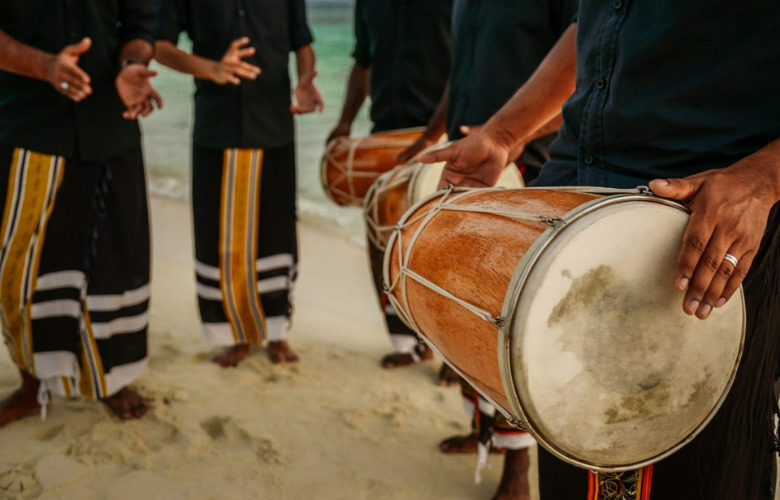
Boduberu. For me, the background music to my island life. The rhythms grew dear to my heart and accompanied me through the years during which I lived and worked on Maldivian islands. The bodu beru is a Maldivian drum, made of wood from coconut tree trunk, and often grouped in trios. The instrument is used to accompany the traditional dance of the same name, the Boduberu.
Boduberu actually means big (bodu) drums (beru). The drums are made of coconut wood as is the case for most island drums across the globe.
In fact, the music and overall performance of Boduberu is similar to some of the songs and dances found in east and southwest Africa. It is likely that the music was introduced to the Maldives by sailors from the Indian Ocean region.
Researchers have suggested that Boduberu first made an appearance in The Maldives in the 11th Century AD, or possibly even before that.
The bodu beru drumheads were traditionally made of Stingray and Manta Ray skin. However, nowadays, due to environmental considerations they are made of goat skin.
Either way, the skin is tightened to produce a good beat and to enhance the quality of the sound.
The traditional Boduberu performance is a combined dance and song to the rhythm of these drums. The routine starts with a slow beat and will slowly lead to a hyperactive, frenetic, and tumultuous beat.
It is performed in large groups of fifteen to twenty performers. Which will include drummers and singers. Of this group, most will also be dancers.
Additionally to the drums, there is also a small bell and an onungandu – a small piece of bamboo with horizontal grooves, from which raspy sounds are produced by scraping.
The dancers of the group follow the traditional dance routines. These are, like the accompanying music, first mesmerizingly slow then speed up.
When the beat upsurges and the song reaches a crescendo, the movements of the dancers in the group become wild and frantic. Some of them may even fall into a trance.
The songs can be romantic, patriotic, or satirical in nature.
There is no specific age group for the participants in this enthusiastic folk music. However, it is usually performed by men only.
The traditional costume of Boduberu is a sarong and a white shirt. But, the contemporary costumes are more varied and may change depending on the occasion.
Originally, Boduberu was a tribal dance performed mostly during festive seasons such as Eid, the big celebration after the month of Ramazan (the Maldivian word for ‘Ramadan’).
Over time, Boduberu evolved and became more widely accepted as the music of the common people. Whenever people gathered together in the island communities, Boduberu became a natural part of their enjoying time together.
A notable point about Boduberu is its noise and sometimes meaningless lyrics.
If you are sitting close enough, the volume can reach ear-splitting levels. And the lyrics do often not have a meaning because they consist of a mixture of local, neighbouring, and even some African words.
This as well has evolved over the years however, and today, meaningful songs, written in the local Dhivehi language, are also sung to the rhythm of the bodu beru drums.
Boduberu is usually sung after a hard day’s work. The location is up to the performers. Today, Boduberu is an important item of entertainment at stage shows, special occasions, celebrations, and festivals in the Maldives.
Everyone in the audience is invited to dance and clap along during these performances. During tourist visits, Boduberu may even acts as a form of “ice breaker” which helps to bring people of different cultural backgrounds together as the rhythm sweeps them away.
Me, I am still swept away, although my 5 years in the Maldives are now already 16 years in the past. The rhythm of the Boduberu still resonates.
Here three examples for you, found on YouTube:
Khalil Oghab, the Father of Iranian Circus
The Importance of Kindness in Entertainment


Liam Klenk was born in Central Europe and has since lived on four continents. Liam has always been engaged in creative pursuits, ranging from photography and graphic design, to writing short stories and poetry, to working in theatre and shows. In 2016, Liam published his first book and memoir, 'Paralian'.
Read Full Profile© 2021 TheatreArtLife. All rights reserved.

Thank you so much for reading, but you have now reached your free article limit for this month.
Our contributors are currently writing more articles for you to enjoy.
To keep reading, all you have to do is become a subscriber and then you can read unlimited articles anytime.
Your investment will help us continue to ignite connections across the globe in live entertainment and build this community for industry professionals.